Taylor’s interview with Lennis Campbell for Food Forever
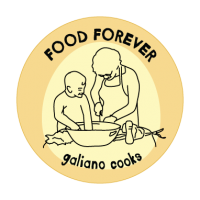 Lennis: We grew lots of vegetables when I was a child, and later on we lived where there were abandoned orchards and we used to go and pick apples because they would stay on the ground, one or two, and we would throw one apple down at a time for them to catch them, so they wouldn’t get bruised…and that way they would last, sometimes right up to February a nice King apple would last. And it was so good then! That’s how we kept our fruit, that’s what fruit we had.
Lennis: We grew lots of vegetables when I was a child, and later on we lived where there were abandoned orchards and we used to go and pick apples because they would stay on the ground, one or two, and we would throw one apple down at a time for them to catch them, so they wouldn’t get bruised…and that way they would last, sometimes right up to February a nice King apple would last. And it was so good then! That’s how we kept our fruit, that’s what fruit we had.
And when I was littler and we lived by a lake, we used to catch fish. But we had no fridge, so we used to salt them and keep them, and then when you wanted to cook them, they would just be covered in salt, so we would have to wash it all off and then soak them for a few hours to get
some of that saltiness out, and then we would cook them. And we always had a cow or more than one, we all learned to milk a cow by the time we were six or eight. And so we would milk our cows, but we had no fridge to keep our milk, but we might have two gallons of milk, with the cream on top. ‘Cause we always had Jersey cows. We would take the cream, we’d set it for half a day or so in a cold place down by the well, and then we’d skim the cream off and and then we would in the summertime you great aunt Julie and i would go pick blackberries in our big blackberry patch, it was our job to go and pick blackberries for lunch and for supper,, and we would have blackberries and whipped cream every day because we had so much cream..And my mom and great grandma would make butter, sometimes we did too , with a small churn, not those big ones with the pump type thing. So we’d make our butter. And we canned a lot…fruit forever! Pears, crab apples, plums,applesauce. That was the fruit. And we also canned meat, because we had no fridge. If we butchered an animal we had to can the meat to keep it, and it would be nice and tender.
Taylor: How did you keep your food?
L: Mostly by canning, and by salting the fish when I was very little, and keeping the milk cold down by the well. By the lake, when I was small, this was northern Alberta, where we always had a big garden. The well was at Jedediah island, up the coast. Canning was everywhere. big vegetable garden, canned corn, lots of corn. One time the pressure canner top popped off the pressure cooker and there was corn all over the ceiling. That wasn’t a joke!
T: How was getting food different when you were a kid?
L: We lived isolated very much of the time, and when we bought food we bought it in bulk when we did buy food, big bags of dried beans and big bags of dried peas, and the rest of the food mostly, and wheat, for porridge.We would cook that up to supplement the food that we grew. Mostly we grew our own or collected it from abandoned orchards.
T: What is your favorite local food?
L: Here on Galiano? mostly I like fruit. I like King apples, they’re my favorite, they’re local, they’re right here.
T: Tell me about a food memory you have from your childhood.
L: Well, there were lots of children in our family so no one ever complained about what was to eat. So we quickly got whatever we could and ate! We didn’t want that because it wasn’t coming around again, the plate would be empty by the time it got back!
My favorite food memory..Making ice cream..it was nummy! That was it! That was when I was very little. One time my mother got the ice people to bring ice, and we had a big pile of sawdust,and they buried it in sawdust, because there was no fridge, there was no electric, we lived very far from electricity. And we didn’t have propane fridges or anything in those days, then in the summer we would dig it out from the sawdust, break it up with a sledgehammer, it came in big blocks, and we had a ice cream churn with a churn you turned by hand, there was a little container in the middle that you put the custard in; we had our own cows, and we’d add vanilla and sugar and good stuff in there….and then around the edge in the bigger container, the wooden container, you would put crushed ice and coarse salt, that would keep the ice frozen longer, and the inner thing was hooked to a handle that when you turned it it kept turning around and around and inside, in the inner container where the ice cream was being made, there were little wooden paddles that would scrape it off the edge as it got cool and then push it into the middle, and then more creamy custard would be cooling, making delicious ice cream so we had ice cream right at our house, without going miles to the store.
T: What seasonal food did you eat?
L: In the summertime we ate all our own vegetables and we ate fish and some of our own animals, sometimes sheep, I remember once we had goat but it wasn’t my favourite food memory.
T: What was the flavour of the ice cream?
L: Vanilla. We didn’t put fruit, I don’t recall putting fruit, cause the fruit wouldn’t be ripe yet, by that time the ice would be melted, because it would be very hot in the summer. And we used to pick wild strawberries, and wild raspberries too, there would be lots up there.
T: How do you overwinter your food?
L: Right now, how do I overwinter it? I still can, peaches and raspberries, pears and crab apples…fish. I love canned fish, salmon. I have a freezer that I use as well.
T: Where do you shop for your food?
L: I usually shop for most of my food in Sidney, at Fairway or the Co-op. Some things on Galiano. Usually on my trips to town, when I have to go overnight.
T: How did obtaining food change for you when you came to Galiano?
L: Most of my life I’ve lived isolated, so I bought food when I was in town and packed it. When I was first married and we were logging out on the mainland it used to be a whole day trip to come to town and get groceries. I remember once forgetting the eggs and the crew wouldn’t be happy with no eggs, I forgot a whole twelve or fifteen dozen eggs and had to go all the way back and get some. And I still pack. I’ve got a truckload of groceries that I haven’t finished unloading yet from today’s trip!
T: What foods make you think of spring?
L: Salmonberries. I guess. The first fruit to be edible in the spring.
T: What foods make you think of summer, and why?
L: Peas on the pod straight from the garden. I know a story about some boys, not from my family, but when I was little, this is a very cute story. They were out stealing peas from the garden and their mom asked them to quit pickin’ the peas out in the garden, so you know what they did? They were still in the garden, maybe they were supposed to be weeding,and they would reach up, split the pod open, and strip the peas out and leave the empty pods hanging .Weren’t they nasty boys?
T: What foods make you think of fall?
L: Ffish, pears, blackberries in late summer…pumpkin pie.
T: What food make you think of winter?
L: Soups and stews. I love pea soup, it’s my favourite.
Taylor had a recipe that she wanted me to give, a BREAD RECIPE.
The fruit and seed bread: I put flax, sunflower seeds, pumpkin seeds, cracked wheat, millet, ground brown rice, cornmeal ,well, don’t put the cornmeal in, but the other I put in …cook it on the stove like a porridge for at least a half hour, and then you can let it sit for a long time, I do that in water, then I cook in soy milk, some cornmeal, that thickens it, then I add molasses,eggs, and some lemon juice, it helps the yeast work, and in a little while I put a bit of sugar, and some yeast, and let it bubble, and then I add brown flour and whip it in till it’s sticky and thick, too thick to whisk any more, and then I add unbleached white flour till it’s bread. The last time I made it, I don’t know whether it was the weather or what but it seemed to come up and then it fell down and I was lamenting it and your brother said that I shouldn’t worry because maybe the next time I made it I’ll learn to make it right again. I forgot..I also put chopped up dried apricots and craisins in.
Here’s some more about storing food: With potatoes, to keep them, we used to have a little trapdoor in the floor, and there was a hole under the house where we kept them, so they wouldn’t freeze, because it would snow all winter there. When we lived on Jedediah we had dug a big hole in the ground and we kept them down in that hole and covered it over so that they wouldn’t freeze. Even today I keep my potatoes in the coldest part of the house.
In the logging camp, when we forgot the eggs, I think we went halfway back, we could phone from there and then somebody else brought them out, because it was a long ways out, it took us two and a half hours by boat and then we had to go across Quadra and then catch the ferry on the other side to get to town….somebody rounded them up on Quadra for us and then brought them out most of the way. For a logging crew, they want their eggs for breakfast. You had a big list, and you tried not to forget things.
Even when I lived in town, I always just shopped one day a week. One shopping day, go get it and be done. And if you didn’t have it, well, just make something else. Don’t drive off to the store to get it just because you wanted to make that certain thing. You can substitute…the recipe’s a guideline. That’s all. You do the rest. Sometimes you forget how and your bread falls!
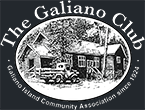
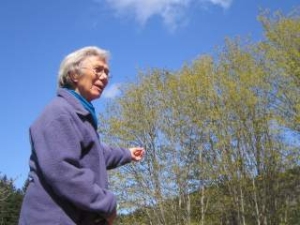 “I grew up in a sterile urban environment where I thought that the whole world was paved and that kind people dug up the pavement to plant seeds and let plants grow. My only joy was what was in the window boxes, my life long desire to be in nature.”
“I grew up in a sterile urban environment where I thought that the whole world was paved and that kind people dug up the pavement to plant seeds and let plants grow. My only joy was what was in the window boxes, my life long desire to be in nature.”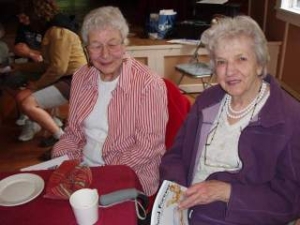 We lived in Cheshire England, the war was on, the war started in ’39. Food was rationed, we were only allowed so much per week per person. We were only allowed one egg per week per person. The food that was rationed for families was generally termed as fats which was butter or margarine or lard plus sugar and meat. Meat was rationed in a different way instead of them saying you can have so many ounces per week it would go by price, so they may say that for this period of time your meat ration would be a shilling. Therefore when you went to the butchers you would look around for the cheapest cut. You may get a lot of cheap meat or you may decide to get two chops. We were rationed because we were at war and we were an island and we got as lot of our food from different countries. The Merchant Navy sure helped us out. The convoys coming across the Atlantic they helped us out with food. Sometimes the rations were decided on by whether there had been a lot of shipping that had been bombed or torpedoed and there would be not as many ships coming in with food so then we knew that our rations would not be as big. We were often hungry. Oranges were very, very scarce and the only people to get oranges were expectant mothers and toddlers for the vitamin c. I don’t remember oranges at all and I never ate a banana until I came to Canada. Even sweets were rationed, sweets and chocolate you couldn’t just go to the store and buy some you needed a ration card. We couldn’t believe the variety of food when we came to Canada; rows and rows of cookies I remember particular. Even now I prefer to shop in a small shop where I can only see so many cookies so I don’t have to choose from 50 packets of cookies. We had never seen so much food. Well the ration was on for ten years by the time we came over so we had never seen so much food. We came over in ’49 and the rationing went on until ‘53/’54. The war was over in ’45 but we were still on ration. After the war we sent food to Germany and Europe. We were in need but they were more in need.
We lived in Cheshire England, the war was on, the war started in ’39. Food was rationed, we were only allowed so much per week per person. We were only allowed one egg per week per person. The food that was rationed for families was generally termed as fats which was butter or margarine or lard plus sugar and meat. Meat was rationed in a different way instead of them saying you can have so many ounces per week it would go by price, so they may say that for this period of time your meat ration would be a shilling. Therefore when you went to the butchers you would look around for the cheapest cut. You may get a lot of cheap meat or you may decide to get two chops. We were rationed because we were at war and we were an island and we got as lot of our food from different countries. The Merchant Navy sure helped us out. The convoys coming across the Atlantic they helped us out with food. Sometimes the rations were decided on by whether there had been a lot of shipping that had been bombed or torpedoed and there would be not as many ships coming in with food so then we knew that our rations would not be as big. We were often hungry. Oranges were very, very scarce and the only people to get oranges were expectant mothers and toddlers for the vitamin c. I don’t remember oranges at all and I never ate a banana until I came to Canada. Even sweets were rationed, sweets and chocolate you couldn’t just go to the store and buy some you needed a ration card. We couldn’t believe the variety of food when we came to Canada; rows and rows of cookies I remember particular. Even now I prefer to shop in a small shop where I can only see so many cookies so I don’t have to choose from 50 packets of cookies. We had never seen so much food. Well the ration was on for ten years by the time we came over so we had never seen so much food. We came over in ’49 and the rationing went on until ‘53/’54. The war was over in ’45 but we were still on ration. After the war we sent food to Germany and Europe. We were in need but they were more in need. M: When you were a child, how did you get your food?
M: When you were a child, how did you get your food?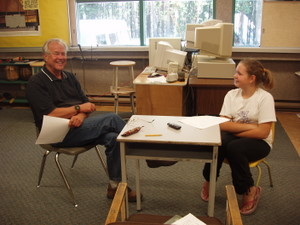
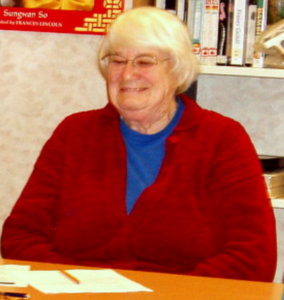 “I do have a food memory, and it’s about lack of food. I was a child in the 1930’s when there was a nasty depression, as we’re having a recession now as they call it. But then it was The Great Depression.
“I do have a food memory, and it’s about lack of food. I was a child in the 1930’s when there was a nasty depression, as we’re having a recession now as they call it. But then it was The Great Depression.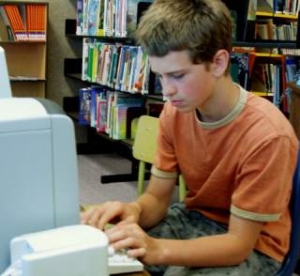 Jacob: When you were a child, how did you get your food?
Jacob: When you were a child, how did you get your food? When you were a child how did you get your food?
When you were a child how did you get your food?